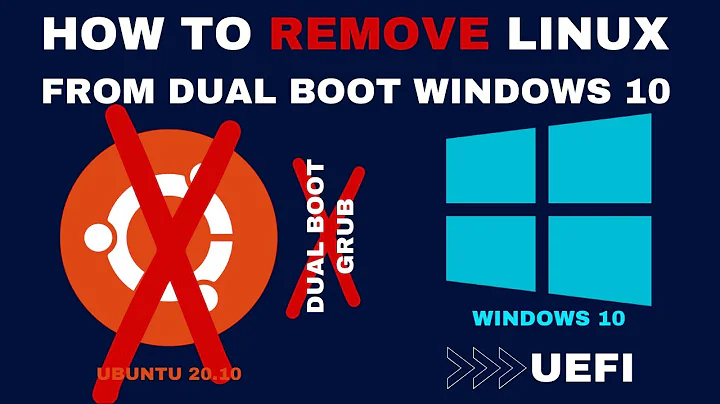Deleted Ubuntu partition and can't access Windows any more
Solution 1
If you type exit it will then take you back to the options where you can select your Windows Partition.
Doing this will allow you to access your Windows OS and use it as normal temporarily, until you can re-install the Kernals and uninstall Ubuntu properly.
Solution 2
Try this:
Boot from a Windows 8 recovery Cd/Dvd/Usb.
If you don't have a recovery drive , then you will either have to install the drive into another Windows 8 machine or obtain a Windows 8 recovery drive.
You will need to choose the
languageandtime settings.Choose
Repair Your Computer.Choose
Troubleshooting.Choose
Advanced Options.Choose
Command Prompt.
Now, You must use the DISKPART tool to verify that the UEFI partition has a drive letter assignment.
Run:
DISKPART
In this test we know the disk 0 is our boot HDD
DISKPART> sel disk 0
Disk 0 is now the selected disk.
DISKPART> list vol

We need to assign a drive letter to UEFI partition (volume 3)
DISKPART> sel vol 3
Volume 3 is the selected volume.
DISKPART> assign letter=G:
DiskPart successfully assigned the drive letter or mount point.
Exit DiskPart tool:
DISKPART> EXIT
Now, You need to change to the boot folder on the UEFI volume.Depending on the way Windows was installed this path maybe one of the following.
cd /d G:\Boot\
cd /d G:\EFI\Microsoft\Boot\
cd /d G:\ESD\Windows\EFI\Microsoft\Boot\
Now, You will need to enter three command lines to repair the BCD store.
bootrec /fixboot
bootrec /fixmbr
bootrec /rebuildbcd
Solution 3
You deleted your kernels and GRUB files, so you will not be able to boot anything. Get a Live CD/USB of a distribution you want and install it in that same partition. Then you will be able to boot Windows again.
Related videos on Youtube
Cosworth66
Updated on September 18, 2022Comments
-
Cosworth66 over 1 year
I have a large iOS project in Objective-c that also has a large number of C++ classes in a 6 subfolders. If I have all of the C++ source code in the iOS project and compile from the source files, everything compiles and works just fine. All good so far.
I wanted to move all of this C++ code to a static library, so I created a new project and a wrapper for my classes and compiled it as a Static Library based on the numerous sets of instructions on SO. It compiles without any errors and created the .a output file with the appropriate header.
When I include this Static Library into my project I get 11 errors related to:
Undefined symbols for architecture arm64: "Configuration::Configuration()", referenced from: ___cxx_global_var_init in libMInterfaceLib.a(M- 3fdac31d875d4f01157909522738d4c95b3c465d55314d375878e8f2faec0803.o) "Type::GetSizes(int, int, int&, int&, int&)", referenced from: CM::BitSizes() in libMInterfaceLib.a(M- 3fdac31d875d4f01157909522738d4c95b3c465d55314d375878e8f2faec0803.o)When I use the lipo info command I get confirmation that my Static Library is architecture: arm64
$lipo -info libMInterfaceLib.a Non-fat file: libMInterfaceLib.a is architecture: arm64Which makes sense because I'm building the Static Library for a device and including it in a device build. I'm not using a Simulator for this project because it needs a live camera so I only need one Architecture which is arm64.
If I create a Static Library from the same code for the Linux version of the application it works just fine, so I know the basic code, headers and file structure is good. That Static Library says it is architecture x86_64 according to lipo -info which make sense.
$lipo -info libMInterfaceLib-OSx.a Non-fat file: libMInterfaceLib-OSx.a is architecture: x86_64The other thing I see is that the .a file built by XCode as a Static Library is 732KB, but the file built by eclipse for Linux from exactly the same source files is 2.2MB. Why would they be so different? All of the source code that is supposed to be included is 1.6MB.
I get the feeling that the problem is not that the Static Library is the wrong Architecture, but that it is not including all of the C++ files that are in the subfolders of the project. The other issue I see is that if I misconfigure the Static Library XCode Project to compile as an executable, I get exactly the same set of errors as I get when I include the Static Library into the device project, but I don't quite know what to make of that other than its not compiling all of the files. Its also super fast to compile which leads me to believe again that its not building everything into the Static Library that it should. Remember, when this C++ source code is added and compiled as part of the main project it all works fine.
Does anyone know how to ensure that XCode will include all of the files in the subfolder and classes that are associated with them? Is there a special linker setting that I need to be using in XCode to get it to link all of the C++ files that are part of the Static Library project?
Anyone know where I'm going wrong here?
Any help and guidance is greatly appreciated.
-
Ronald about 5 yearsCan't agree more. Happened to me once; I've managed with this workaround.
-
 Admin about 4 yearsIt won't let me type exit.
Admin about 4 yearsIt won't let me type exit. -
Hettomei almost 3 yearsI m very glad I am in this situation to temporary work ! thanks for the "quick" answer.
-
matteoh about 2 yearsDo you know any tutorial that shows step by step how to create a C++ static library for iOS, by any chance? Thanks.
-
Cosworth66 about 2 yearsHi @matteoh, I looked back through my notes and here are the links to the SO resources I used to build my static library. Hopefully these help you too. stackoverflow.com/questions/4654534/… stackoverflow.com/questions/18811072/…





![How to Remove Ubuntu or Other Linux from Dual Boot [Safely and Easily]](https://i.ytimg.com/vi/Kskjujf2TYc/hq720.jpg?sqp=-oaymwEcCNAFEJQDSFXyq4qpAw4IARUAAIhCGAFwAcABBg==&rs=AOn4CLDQYG7uVNyfBg9o6ovUzOVGKxqMaw)

